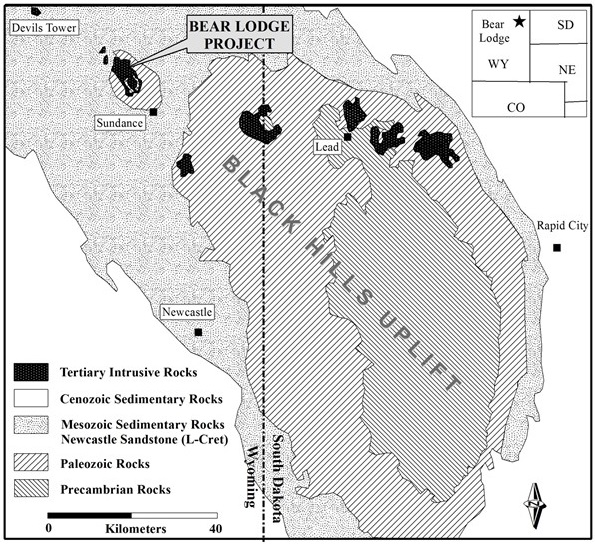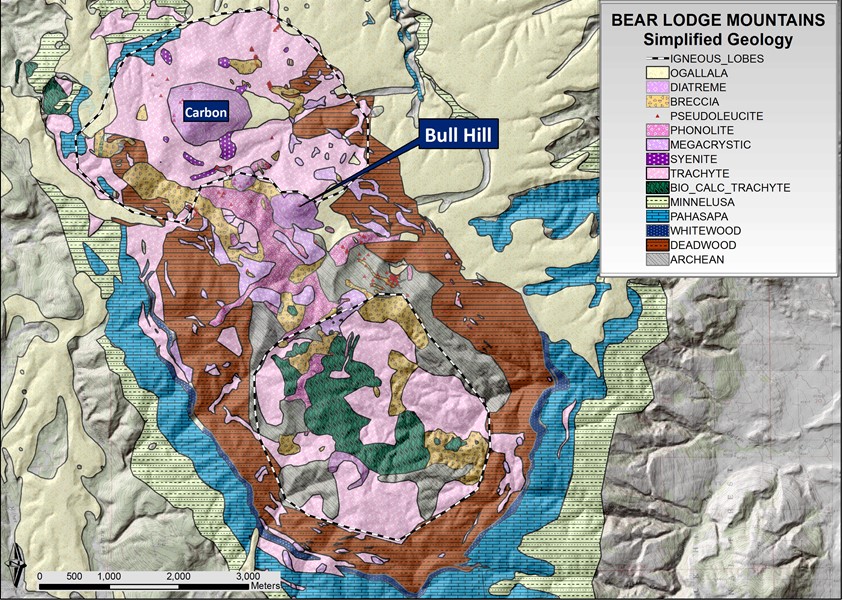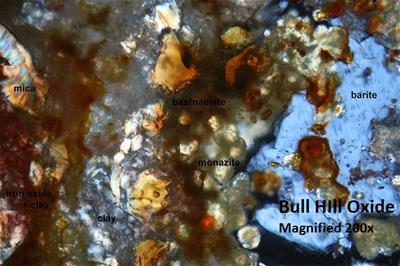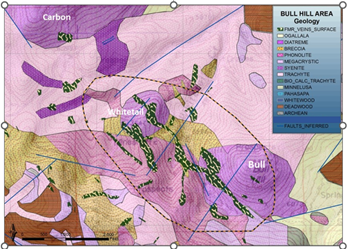Geology and Mineralization
Exploration History
The Bear Lodge Mountains were initially prospected for gold during the late nineteenth and early twentieth century. Rare earth mineralization was first discovered in 1949, and he U.S. Bureau of Mines conducted some limited exploration in the early 1950s.
In 1972, exploration was reinitiated by Duval Corporation and focused on copper/molybdenum, but it was soon determined that Bear Lodge had the potential to host an economically significant rare earth (REE) deposit. Molycorp Inc., the only domestic rare earth producer at the time, was brought in as a partner but was not able to advance the project primarily due to weakening market fundamentals. At the same time, the U.S. Geological Survey conducted field and laboratory studies and published a professional paper that concluded that the Bear Lodge area had one of the largest resources of total REEs in the United States.
Hecla Mining Company explored the Bear Lodge area, first for rare earths and then for gold between 1987 and 1991. Their exploration efforts identified the Bull Hill deposit based on three drill holes and the Whitetail Ridge mineralization based on two drill holes. Between 1994 and 1996, the property was explored for gold.
In 2004, Rare Element Resources initiated REE exploration activities in the Bull Hill target area. Between 2004 and 2013, a total of more than 160,000 feet of drilling was completed in over 200 core holes that range in depth from 88 to 1,886'. In total, the entire project area has close to 500 drill holes completed for a total of approximately 285,000' of core. Geophysical and geological mapping also identified and/or confirmed REE exploration target areas at Bull Hill NW, Whitetail Ridge, Bull Hill West, Carbon and East Taylor.
This work great expanded the understanding of the mineralization at Bear Lodge and will provide a substantial body of information that will be used to identify a mineral resource once the economic evaluation of the Company recovery/separation technology is completed.
Geology
The Bear Lodge Mountains are part of the Black Hills Uplift, formed by the intrusion of a Tertiary-aged alkaline igneous complex during the waning stages of the Late Cretaceous-early Tertiary Laramide Orogeny. The uplift has a northwesterly orientation and extends from the western South Dakota - Nebraska border through northeastern Wyoming into south-eastern Montana. The exposed basement consists of Archean and Proterozoic schist, gneiss, and granite overlain by Paleozoic and Mesozoic clastic and carbonate sedimentary rocks that were subsequently eroded from higher elevations. The Paleozoic and Mesozoic rocks were subjected to large-scale monoclinal folding that encircles the Black Hills Uplift. Younger Oligocene, Miocene, and Pliocene sediments disconformably overlie the older sedimentary and igneous rocks at lower elevations of the uplift.
Project Location and Geological Setting of Bear Lodge Mountains

Source: Ray and Clark, 2015
The Bear Lodge mining district is in the Bear Lodge Mountains, near the western end of the northern Black Hills intrusive belt. The Bear Lodge Mountains expose and are underlain by multiple alkaline plugs, sills and dikes intruded into Archean basement and Paleozoic and Mesozoic sediments approximately 38 to 51 million years ago, forming an elongate, northwest-trending dome.
Geologic Map of the Bear Lodge Mountains

Source: Ray and Clark, 2015, after Staatz, 1983
The Bear Lodge REE deposits are sited near the axis of the elongate dome and are associated with carbonatite and silicocarbonatite dikes, veins, and stockwork hosted by the Bull Hill and Whitetail diatremes. The northwest alignment of diatremes extends from Bull Hill through Whitetail Ridge to Carbon Hill and coincides with numerous north- to northwest-striking alkalic dikes and mineralized zones.

Carbonatite and silicocarbonatite dikes strike northwesterly to northerly and intrude diatremal heterolithic breccias and surrounding trachyte, phonolite and igneous intrusion breccias. Within the Bear Lodge deposit, the dikes are concentrated within the margins of the diatreme and in adjacent wall rocks along the northwest corridor, extending from the south and west flanks of Bull Hill through the Whitetail diatreme towards the Carbon Hill diatreme. The carbonatite bodies range in size from veinlets to dikes that can reach more than 15 meters in width. A swarm of wide, steeply dipping carbonatite dikes cut across the southwestern flank of Bull Hill. The dike swarm has been traced over 300 meters along strike and down dip, and it remains open in the down dip direction. Rare earth-bearing minerals within the carbonatites are mainly ancylite and rare earth fluorocarbonates of the bastnaesite group.
Geologic Map of the Project Area

Source: Ray and Clark, 2015